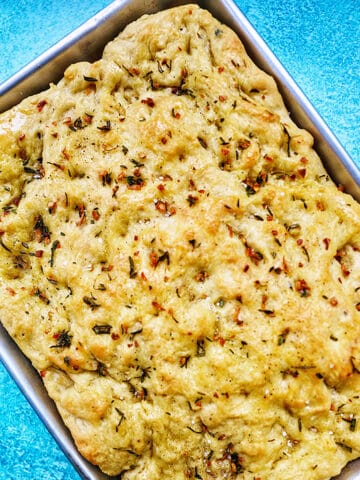Making dough ahead of time is a great way to help pizza night go much more smoothly. Here’s how to store pizza dough the right way so you get a soft, tasty crust every time.

We do pizza night nearly every Friday. The kids love rolling out their dough and adding individual toppings to make their pizza their own.
But with our schedules getting more and more hectic, we’ve started to make the dough ahead of time and store it for later.
The trick is making sure you store the dough properly so it’s pillowy soft when you bake it.
Jump to:
Before you store your dough, first you need to make it. And it’s easier than you think!
How to make homemade pizza dough

You only need a few simple ingredients to make fresh pizza dough at home — and they may already be in your pantry. They include:
- all-purpose flour
- salt
- sugar
- water
- olive oil
- yeast
The type and amount of yeast you use will help determine the proofing time for your fresh dough. We use a quick-rise yeast packet to help speed it up.
To make the dough:
- First, combine the dry ingredients together in a stand mixer. Then mix in the olive oil and water until it forms a ball.
- Next, use a bit of olive oil to grease a large bowl. Place the dough inside, cover it with plastic wrap, and set it somewhere warm so it can rise. You can leave it on a kitchen countertop at room temperature or even in an unheated oven.
- After 1-2 hours, the dough should double in size, and it’s ready to be rolled out to make your pizzas.
👨🏼🍳 Don’t let your pizza dough rest for too long or it could overproof. This can prevent the dough from rising when you bake it.
⭐️ If you don’t plan on making your pizzas right away— or you simply want to make a large batch of dough ahead of time — you can store it in the fridge or the freezer until you’re ready to use it.
How to store pizza dough in the refrigerator
If you’re going to use the dough within a few days after you first make it, it’s best to store it in the fridge. Here’s how to do it:
- Like above, you’ll want to let the dough rise for 1-2 hours at room temperature first.
- Then divide it into a few pizza dough balls. I use a pastry knife to help divide it cleanly.
- Place the dough in separate, resealable airtight containers. For best results, use glass or pyrex ones. This will help prevent sticking when you take the dough out. If you have plastic containers, you can line them with wax paper first.
The fridge is also a great way to store leftover pizza dough. Your dough should keep for up to a week.
Once you’re ready to use the dough, remove it from the fridge and let it come to room temperature. It should take about an hour. This helps soften the dough so it’s easier to roll out.
Then add your favorite toppings and bake your delicious homemade pizza.
How to store pizza dough in the freezer
If you like to plan way ahead, or simply have some leftover or extra dough you want to save for your next pizza night, the best place to store it is in the freezer.
The process is similar to storing it in the fridge. After you make the dough, let it rise for a couple of hours, then divide it into portions.
Place each portion into individual airtight containers and pop them into the freezer. The containers will help prevent freezer burn and keep odors from other foods from seeping into the dough.
You can also place the dough portions in a freezer bag, but I find it’s harder to remove the dough from them when it comes time to use it.
Your pizza dough should say good for up to 3 months in the freezer if stored properly.
How to defrost frozen pizza dough
When you’re ready to use the dough, you’ll need to let it thaw out first. Here are 4 different methods to do it:
Method 1 – In the fridge overnight
The best way is to let it defrost overnight in the refrigerator. Keeping the dough constantly cool this way will help regulate the yeast. If it becomes too active too quickly, it can affect the rise when baking.
That said, the dough will still rise a bit when you do this, so you’ll want to move it to a large, covered bowl.
After about 10 hours, remove it from the fridge and let it rise again at room temperature for about an hour. When it’s soft and pliable, stretch it out and add your toppings!
Method 2 – On a countertop
If you’re short on time, you can move the frozen dough from the freezer into a large bowl covered with cling wrap — then let it defrost at room temperature on a countertop. This should take a couple of hours.
The yeast will warm more quickly this way, so you want to check on it after the first hour to make sure it doesn’t rise too rapidly.
Method 3 – In a cold water bath
Another way to speed up the defrosting process is to use a cold-water bath. To do it, place a piece of dough in a tightly sealed, heavy-duty freezer bag.
Fill a large bowl will lukewarm to cool water and gently place the bag in it. This will help the dough thaw in 1-2 hours.
Remove it from the plastic bag and place it in a covered bowl. Then allow it to rise for another 30 minutes or so at room temperature before rolling it out.
Method 4 – In the microwave
If dinner time is fast approaching and you need to thaw out your dough quickly, you can use the microwave.
Start by transferring the dough from the freezer container to a microwave-safe plate. Then cover it with parchment paper or a bowl and tap the microwave’s defrost setting.
Defrost it for 30 seconds at a time until the dough becomes soft. This should take about 3 minutes.
Then let the dough rest at room temperature on a kitchen counter for another 30 minutes.
Be careful not to overdo it in the microwave as you could end up inadvertently cooking the dough, which will affect the texture when you eventually bake it.
How do I know if my pizza dough has gone bad?
If you leave your dough to rest at room temperature for too long, you run the risk of overproofing.
What is overproofing?
As dough proofs, the yeast activates and starts to feed on sugars in the flour. This releases carbon dioxide gas bubbles and causes the dough to rise. If the dough rests for too long, the yeast will consume all the sugar and stop producing air bubbles.
This “overproofing” can leave you with dough that becomes very sticky and hard to shape. It can also prevent your dough from rising when you bake it. So, instead of having an airy, pillow pizza crust, you could end up with a flat, bland one.
Other signs of spoiled pizza dough
While overproofing can affect the rise of your dough, other factors can affect whether the dough is still safe to eat at all.
If your pizza dough has a sour smell or just smells off, that may be a sign of harmful bacterial growth.
An overly slimy texture can also be a result of bacterial growth. This will be different from simply an oily texture that will result from letting the dough rest in a greased bowl, and it may accompany one of the other signs of spoilage.
If you notice discoloration on the dough, that could be an indication of mold growth.
Any of these issues could mean that your pizza dough has spoiled, so if you detect them, it’s best to simply discard it.

FAQ
Quick rise yeast or instant yeast is a great option for pizza dough. It’s easy to use and helps reduce the amount of time it takes for your dough to rise. You can also use active dry yeast, though that will extend your rise time by about half.
Using quick dry yeast will accelerate the rise of your pizza dough. In most cases, the dough will rise in 1-2 hours with this type of yeast. You can also speed up proofing by putting it in the oven at the “proofing” setting. Another method is to place it in the microwave along with a glass of hot, steaming water. The steam will create humidity and accelerate the rise.
Homemade pizza dough will last about a week in the fridge if kept in an airtight container. It can keep for up to 3 months in the freezer. Storing it in a glass or pyrex can help prevent the dough from sticking to the container.
More food storage answers
Find out the best ways to store other foods you love. Tap the links below.






Leave a Reply